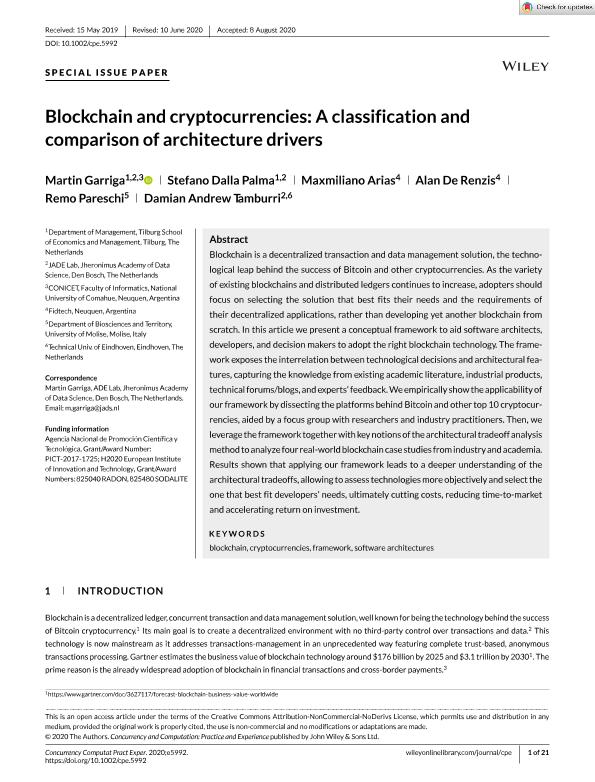Mostrar el registro sencillo del ítem
dc.contributor.author
Garriga, Martín

dc.contributor.author
Dalla Palma, Stefano
dc.contributor.author
Arias, Maxmiliano
dc.contributor.author
de Renzis, Alan Ismael

dc.contributor.author
Pareschi, Remo
dc.contributor.author
Andrew Tamburri, Damian
dc.date.available
2022-09-16T13:39:24Z
dc.date.issued
2020-08
dc.identifier.citation
Garriga, Martín; Dalla Palma, Stefano; Arias, Maxmiliano; de Renzis, Alan Ismael; Pareschi, Remo; et al.; Blockchain and cryptocurrencies: A classification and comparison of architecture drivers; John Wiley & Sons Ltd; Concurrency and Computation: Practice and Experience; 8-2020; 1-21
dc.identifier.issn
1532-0626
dc.identifier.uri
http://hdl.handle.net/11336/169064
dc.description.abstract
Blockchain is a decentralized transaction and data management solution, the technological leap behind the success of Bitcoin and other cryptocurrencies. As the variety of existing blockchains and distributed ledgers continues to increase, adopters should focus on selecting the solution that best fits their needs and the requirements of their decentralized applications, rather than developing yet another blockchain from scratch. In this article we present a conceptual framework to aid software architects, developers, and decision makers to adopt the right blockchain technology. The framework exposes the interrelation between technological decisions and architectural features, capturing the knowledge from existing academic literature, industrial products, technical forums/blogs, and experts´ feedback. We empirically show the applicability of our framework by dissecting the platforms behind Bitcoin and other top 10 cryptocurrencies, aided by a focus group with researchers and industry practitioners. Then, we leverage the framework together with key notions of the architectural tradeoff analysis method to analyze four real-world blockchain case studies from industry and academia. Results shown that applying our framework leads to a deeper understanding of the architectural tradeoffs, allowing to assess technologies more objectively and select the one that best fit developers´ needs, ultimately cutting costs, reducing time-to-market and accelerating return on investment.
dc.format
application/pdf
dc.language.iso
eng
dc.publisher
John Wiley & Sons Ltd

dc.rights
info:eu-repo/semantics/openAccess
dc.rights.uri
https://creativecommons.org/licenses/by-nc-nd/2.5/ar/
dc.subject
BLOCKCHAIN
dc.subject
CRYPTOCURRENCIES
dc.subject
FRAMEWORK
dc.subject
SOFTWARE ARCHITECTURES
dc.subject.classification
Ciencias de la Computación

dc.subject.classification
Ciencias de la Computación e Información

dc.subject.classification
CIENCIAS NATURALES Y EXACTAS

dc.title
Blockchain and cryptocurrencies: A classification and comparison of architecture drivers
dc.type
info:eu-repo/semantics/article
dc.type
info:ar-repo/semantics/artículo
dc.type
info:eu-repo/semantics/publishedVersion
dc.date.updated
2022-09-15T14:52:33Z
dc.journal.pagination
1-21
dc.journal.pais
Reino Unido

dc.description.fil
Fil: Garriga, Martín. Universidad Nacional del Comahue; Argentina. Consejo Nacional de Investigaciones Científicas y Técnicas; Argentina
dc.description.fil
Fil: Dalla Palma, Stefano. Tilburg School of Economics and Management; Países Bajos
dc.description.fil
Fil: Arias, Maxmiliano. No especifíca;
dc.description.fil
Fil: de Renzis, Alan Ismael. Consejo Nacional de Investigaciones Científicas y Técnicas; Argentina
dc.description.fil
Fil: Pareschi, Remo. Università degli Studi del Molise; Italia
dc.description.fil
Fil: Andrew Tamburri, Damian. Jheronimus Academy of Data Science; Países Bajos
dc.journal.title
Concurrency and Computation: Practice and Experience

dc.relation.alternativeid
info:eu-repo/semantics/altIdentifier/doi/http://dx.doi.org/10.1002/cpe.5992
Archivos asociados
